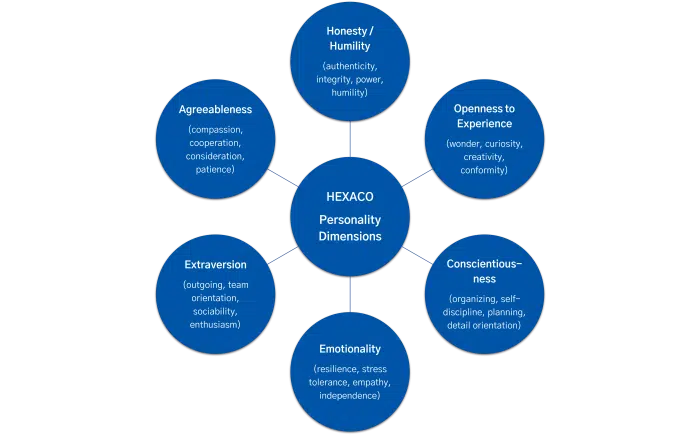Blog » Coaching Models and Techniques » What Is the HEXACO Personality Test
What Is the HEXACO Personality Test
The HEXACO Personality test aka the Hexaco Personality Inventory is a model which assesses one’s personality basis of the traits they possess. Based on data from a series of lexical investigations including numerous European and Asian languages, Ashton and Lee developed the six-dimensional HEXACO model of personality structure, which is described in their book, The H Factor of Personality.

Honesty-Humility (H), Emotionality (E), Extraversion (X), Agreeableness (A), Conscientiousness (C), and Openness to Experience (O) are the six variables or dimensions (O). Each component is made up of traits, and each feature has qualities that correspond to its high and low levels. The HEXACO model, which expands on the work of Costa and McCrae and Goldberg, was built using techniques that are common to other trait taxonomies. As a result, the model has some features in common with other trait models. However, the HEXACO model is distinct in large part because of the addition of the Honesty-Humility dimension.
After reading this article, you will be equipped with the knowledge of the 6 facets of the HEXACO model and their relevancies, the benefits and shortcomings of the model, and knowing whether this model is a good model for personality assessment. So, let’s get started!
History
Kibeom Lee, Ph.D., and Michael C. Ashton, Ph.D., two Canadian psychology professors, created the HEXACO Personality Inventory in 2000.
The investigation into five fundamental personality qualities forms the basis of the inventory. Researchers like Dr. Paul Costa and Dr. Robert McCrae studied these extensively in the 1980s, as did Dr. Donald Fiske and Dr. Paul Costa in the 1940s.
The HEXACO Personality Inventory was developed by Ashton & Lee using the “Big 5,” as these key characteristics are known.
But, Ashton & Lee introduced the Honesty-Humility component when they examined various languages and cultures.
The HEXACO Personality Test has now been widely utilized and has been translated into many different languages.
Breaking Down the Acronym
Six dimensions are used to conceptualize human personality in the HEXACO paradigm. The test in itself is not very long, but does a fairly decent job at analyzing personality types.
Several separate lexical investigations from the past served as the foundation for the HEXACO model. The process of creating personality models has frequently used language-based taxonomies for personality qualities.
This approach makes use of adjectives that characterize human behaviors and tendencies and is founded on the logic of the lexical hypothesis. The adjectives are subjected to factor analysis to determine the bare minimum of independent groups of personality traits.
Each of the six components of HEXACO model have been highlighted below:

Honesty-Humility
High scorers in this area rarely disobey the law, rarely deceive others for their own gain, don’t value luxury or extravagance, and don’t believe they are entitled to a high social rank. Conversely, persons with low scores are materialistic, have an inflated sense of self-importance, and flatter others to achieve what they want.
Emotionality
Individuals who perform well in this area typically feel more anxiety, need more emotional support, have greater empathy for others, and are more afraid of physical risks. Low emotional people don’t fear physical injury, feel more distant from others, feel minimal distress, and are less likely to be open with others.
Extraversion
Extraverted people are self-assured when leading others, feel energized and motivated when interacting with others, have a positive self-image, and flourish in social settings. People who perform poorly in this area might think they’re unpopular, feel exhausted in social settings, feel awkward when they’re the center of attention, and lack outward enthusiasm and optimism.
Agreeableness
High scorers in this trait are more likely to be able to control their temper, judge others leniently, and forgive readily. Low scorers tend to be obstinate, hold grudges against those who have wronged them, criticize others, and become easily enraged when handled unfairly.
High scores are also more able to compromise and meet someone halfway or sometimes even satisfy others by fully compromising on their end of the discussion.
Conscientiousness
High conscientiousness scorers carefully weigh their options, strive for precision and perfection, exercise self-control when pursuing their objectives, and keep their time and environment organized. Low performers in this area are more likely to let mistakes pass, act impulsively, pay less attention to their surroundings or time, and become discouraged by difficult objectives or tasks.
Openness to Experience
People who exhibit this trait well are creative, attracted to unusual people or ideas, immersed in nature and the arts, and curious about various fields of knowledge. Low scorers lack creativity, avoid radical concepts, show no interest in aesthetics, and lack academic curiosity.
These six domains each have four facets that further examine the ways in which personality tendencies may appear. The Honesty-Humility domain, for instance, has a Sincerity gauge that measures people’s propensity for being sincere in their interpersonal interactions.
Unrelated to any of the categories, there is also an Interstitial Scale that assesses people’s propensity for altruism versus antagonistic behavior.
Benefits of the HEXACO Personality Test
6 Traits That Determine Your Personality – HEXACO Personality Test
It can be helpful to understand one’s psychological type better. People may be able to better comprehend their behavior as a result of this. Professionals in the field of mental health may also benefit from personality assessments.
Prior to beginning counseling, Dr. Phillips contends that it is important to understand how patients handle their serious mental health concerns. Psychotherapists can plan their treatments and choose the best therapy option for their patients by facilitating personality tests.
The HEXACO Personality Inventory is easy to give and can be finished in a short amount of time, similar to some other personality inventories.
The HEXACO Personality Inventory has also been linked to the prediction of specific actions. Researchers discovered in one study that the personality test was useful in identifying personality differences between different scholastic majors.
For example, students majoring in business or trade scored higher on extraversion than their peers majoring in physical sciences or mathematics, while students majoring in the humanities and social sciences showed greater openness to new experiences than students majoring in other fields.
Additionally, a meta-analysis discovered that people with greater Openness to Experience and Honesty and Humility scores were more inclined to act in a pro-environmental manner.
Shortcomings of the HEXACO Personality Test
The HEXACO Personality Inventory offers both advantages and disadvantages. According to studies, people who fill out personality inventories can reply to questions based on their social desirability, or in other words, they can answer in a way that makes them look good. 5
The subjective nature of the HEXACO Personality Inventory makes it challenging to adjust participant results for social desirability.
Furthermore, results from studies using the HEXACO Personality Inventory in cross-cultural settings are difficult to generalize.
Personality tests tend to gapingly overlook cultural nuances and differences in cultural upbringing. They will not take into account any variables not covered by the test. As an illustration, a person raised in China would conduct more submissively in an office situation than most Americans would, and might get rated as “more pleasant” or as having “poor confidence” by an American test. Yet, that is not how they perceive themselves or how the majority of Chinese people would view their behavior.
Last but not least, many behavioral psychologists think that the HEXACO Personality may “cage” people into certain categories. Individuals frequently hold onto the idea that their findings, based on the test, are final and irrefutable, although it can be easily noted that our personalities alter and develop through time.
Conclusion
After a thorough understanding and examination of the six categories, the HEXACO Personality Test can be helpful in identifying trends in people’s actions, ideas, and feelings.
This assessment can help individuals understand why they display the traits they do on a personal level, but it can also help mental health professionals by allowing them to use the scores to customize treatment to the client’s needs.
This model can also help recruiters and corporate trainers better understand the workforce in their companies. It can also help people understand their own personality better.
Frequently Asked Questions (FAQs)
What does the HEXACO personality test measure?
The HEXACO personality test assesses six major personality traits: openness to new experiences, agreeableness, emotionality, extraversion, and honesty-humility.
more specific attributes are used to further investigate each of these dimensions, giving a more detailed evaluation of each person’s traits.
The HEXACO personality test evaluates a candidate’s characteristics to better understand how they will approach their work.
Is HEXACO a good personality test?
There is strong scientific evidence that the HEXACO model is solid, and it is at the forefront of scientific personality testing at par with the Big 5 personality test.
What is the difference between the Big 5 and HEXACO?
The addition of the honesty-humility aspect, represented by the characteristics of sincerity, fairness, greed avoidance, and modesty, is the primary distinction between the Big Five and the HEXACO model.
HEXACO also redefines some of the other five factors of the Big 5 personality test to give this model a bit more depth and cultural understanding as compared to the Big 5.

